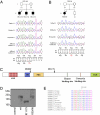De novo mutations in the gene encoding the synaptic scaffolding protein SHANK3 in patients ascertained for schizophrenia
- PMID: 20385823
- PMCID: PMC2867875
- DOI: 10.1073/pnas.0906232107
De novo mutations in the gene encoding the synaptic scaffolding protein SHANK3 in patients ascertained for schizophrenia
Abstract
Schizophrenia likely results from poorly understood genetic and environmental factors. We studied the gene encoding the synaptic protein SHANK3 in 285 controls and 185 schizophrenia patients with unaffected parents. Two de novo mutations (R1117X and R536W) were identified in two families, one being found in three affected brothers, suggesting germline mosaicism. Zebrafish and rat hippocampal neuron assays revealed behavior and differentiation defects resulting from the R1117X mutant. As mutations in SHANK3 were previously reported in autism, the occurrence of SHANK3 mutations in subjects with a schizophrenia phenotype suggests a molecular genetic link between these two neurodevelopmental disorders.
Conflict of interest statement
The authors declare no conflict of interest.
Figures



References
-
- Risch N. Genetic linkage and complex diseases, with special reference to psychiatric disorders. Genet Epidemiol. 1990;7:3–16. discussion 17−45. - PubMed
-
- Gottesman II, Erlenmeyer-Kimling L. Family and twin strategies as a head start in defining prodromes and endophenotypes for hypothetical early-interventions in schizophrenia. Schizophr Res. 2001;51:93–102. - PubMed
-
- Malaspina D, et al. Schizophrenia risk and paternal age: A potential role for de novo mutations in schizophrenia vulnerability genes. CNS Spectr. 2002;7:26–29. - PubMed
-
- Xu B, et al. Strong association of de novo copy number mutations with sporadic schizophrenia. Nat Genet. 2008;40:880–885. - PubMed
Publication types
MeSH terms
Substances
LinkOut - more resources
Full Text Sources
Other Literature Sources
Medical
Molecular Biology Databases
Research Materials

